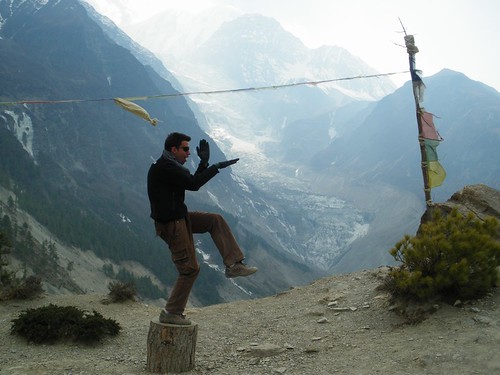 I won't go too deep in details but, in brief, there are two major risks when one gets over 3000 meters. For one, nearly 65% of the people would experience mild symptoms of Acute Mountain Sickness. This means that -due to the low atmosferic pressure and consquent deficit of oxygen in the blood stream- those people are likely to suffer light headaches, difficulties to sleep and dizziness. Up to this point there is nothing to worry about, one must listen to their body and don't go any further; remaining at the same altitude for one or two days would solve the problem. BUT, if someone is stupid enough to continue climbing the Mild AMS can derive into HACE (High Altitude Cerebral Edema) or HAPE (High Altitude Pulmonary Edema). This is serious business, every year one or two people die up there because of them.
I won't go too deep in details but, in brief, there are two major risks when one gets over 3000 meters. For one, nearly 65% of the people would experience mild symptoms of Acute Mountain Sickness. This means that -due to the low atmosferic pressure and consquent deficit of oxygen in the blood stream- those people are likely to suffer light headaches, difficulties to sleep and dizziness. Up to this point there is nothing to worry about, one must listen to their body and don't go any further; remaining at the same altitude for one or two days would solve the problem. BUT, if someone is stupid enough to continue climbing the Mild AMS can derive into HACE (High Altitude Cerebral Edema) or HAPE (High Altitude Pulmonary Edema). This is serious business, every year one or two people die up there because of them.Just to chill this post again, I will add a funny sympthom of AMS that all us developed during the trek. The low pressure in the atmosfere facilitates that the gasses in the intestines expand beyond usual levels which will eventually -and unavoidably- yield a very recomforting turbo boost propelling mountaneers up the hill!
Back to Day 6, morning cultural visit to Bhraga; half an hour trek to Manang (3540 m); acclimatization trip to nearby hill with views over the lake and glacier; and to complete the day a movie at the local cinema. Oh! yesh, there is a movie theater in Manang, the most picturesque I've ever been to (don't miss the yak carpet in the pictures). We watched 'Into Thin Air' a movie about an expedition to Mount Everest gone bad that added some 'anti-cool' to the already 'tense' scenario.
El sexto dia de expedicion tenia un objetivo unico: aclimatar nuestros cuerpos para evitar el mal de altura. No voy a entrar en detalles pero basicamente cuando se superan los 3000 m de altura uno esta expuesto a lo que se conoce como Mal de Altura o Montaña. Las bajas presiones y el deficit de oxigeno en el aire pueden provocar mareos, dolor leve de cabeza y dificultades para conciliar el sueño. Hasta aqui no hay que alarmarse, simplemente hay que escuchar al organismo y no hacer estupideces. Si se detectan estos sintomas se debe permanecer a la altura actual e incluso descender unos metros -si es posible- hasta que el cuerpo se acostumbre (1 o 2 dias). El problema viene cuando uno desoye a su organismo y decide seguir escalando. En ese caso el Mal de Altura puede desembocar en Mal Agudo de Montaña, en dos vertientes: la que conlleva hacia un edema cerebral y la que pudiera ocasionar un edema pulmonar. Esto no es ninguna tonteria, una o dos personas mueren todos los años en el circuito a causa de ellas. En fin, para relajar el ambiente añadire que la mayoria de trekkers, incluido un servidor, sufrimos una curiosa variante del Mal Leve de Montaña que ocasiona que nuestros intestinos se inflen a raiz de las bajas presiones lo cual resulta inevitablemente en un incesante flujo de ventosidades que, junto a mi amado palo, nos habria de propulsar a lo alto de la montaña.
De vuelta al dia 6 dire que basicamente se resume en una visita cultural a Bhraga seguida de un paseo hasta Manang y una excursion a una colina aledaña desde donde disfrutamos de vistas sobre el lago y el glaciar. Por ultimo, matamos el tiempo viendo una peli en el cine local (cosa de otro mundo), mas concretamente vimos 'Into Thin Air', una peli sobre una expedicion al Everest con final dramatico que añadio un poco de emocion al ya de por si enrarecido ambiente.
0 comments:
Post a Comment